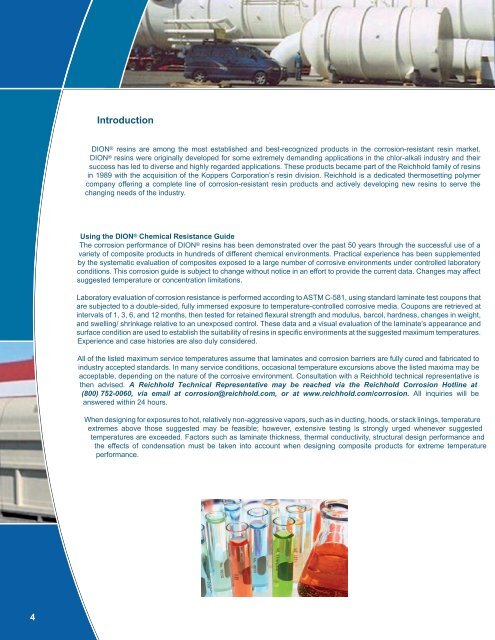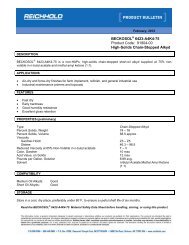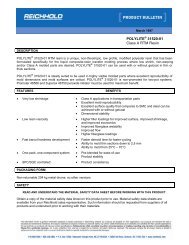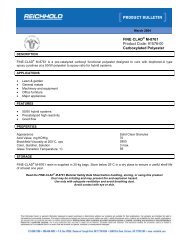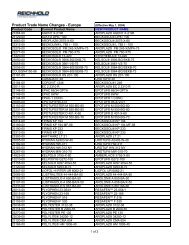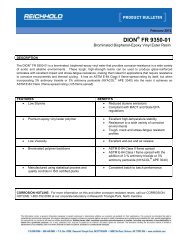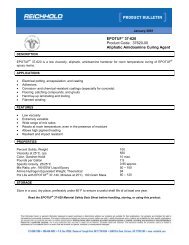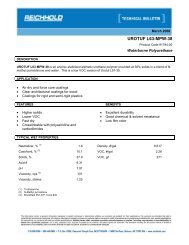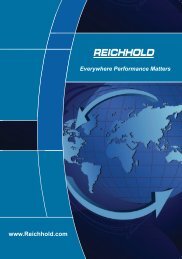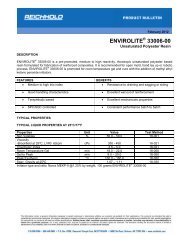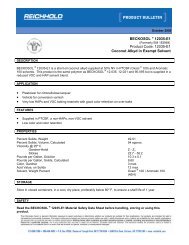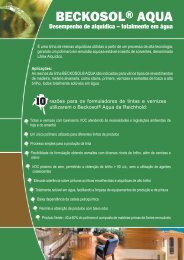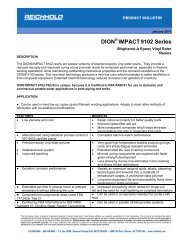CORROSION GUIDE 181108_new table content format ... - Reichhold
CORROSION GUIDE 181108_new table content format ... - Reichhold
CORROSION GUIDE 181108_new table content format ... - Reichhold
Create successful ePaper yourself
Turn your PDF publications into a flip-book with our unique Google optimized e-Paper software.
Introduction<br />
DION ® resins are among the most established and best-recognized products in the corrosion-resistant resin market.<br />
DION ® resins were originally developed for some extremely demanding applications in the chlor-alkali industry and their<br />
success has led to diverse and highly regarded applications. These products became part of the <strong>Reichhold</strong> family of resins<br />
in 1989 with the acquisition of the Koppers Corporation’s resin division. <strong>Reichhold</strong> is a dedicated thermosetting polymer<br />
company offering a complete line of corrosion-resistant resin products and actively developing <strong>new</strong> resins to serve the<br />
changing needs of the industry.<br />
Using the DION ® Chemical Resistance Guide<br />
The corrosion performance of DION ® resins has been demonstrated over the past 50 years through the successful use of a<br />
variety of composite products in hundreds of different chemical environments. Practical experience has been supplemented<br />
by the systematic evaluation of composites exposed to a large number of corrosive environments under controlled laboratory<br />
conditions. This corrosion guide is subject to change without notice in an effort to provide the current data. Changes may affect<br />
suggested temperature or concentration limitations.<br />
Laboratory evaluation of corrosion resistance is performed according to ASTM C-581, using standard laminate test coupons that<br />
are subjected to a double-sided, fully immersed exposure to temperature-controlled corrosive media. Coupons are retrieved at<br />
intervals of 1, 3, 6, and 12 months, then tested for retained fl exural strength and modulus, barcol, hardness, changes in weight,<br />
and swelling/ shrinkage relative to an unexposed control. These data and a visual evaluation of the laminate’s appearance and<br />
surface condition are used to establish the suitability of resins in specifi c environments at the suggested maximum temperatures.<br />
Experience and case histories are also duly considered.<br />
All of the listed maximum service temperatures assume that laminates and corrosion barriers are fully cured and fabricated to<br />
industry accepted standards. In many service conditions, occasional temperature excursions above the listed maxima may be<br />
accep<strong>table</strong>, depending on the nature of the corrosive environment. Consultation with a <strong>Reichhold</strong> technical representative is<br />
then advised. A <strong>Reichhold</strong> Technical Representative may be reached via the <strong>Reichhold</strong> Corrosion Hotline at<br />
(800) 752-0060, via email at corrosion@reichhold.com, or at www.reichhold.com/corrosion. All inquiries will be<br />
answered within 24 hours.<br />
When designing for exposures to hot, relatively non-aggressive vapors, such as in ducting, hoods, or stack linings, temperature<br />
extremes above those suggested may be feasible; however, extensive testing is strongly urged whenever suggested<br />
temperatures are exceeded. Factors such as laminate thickness, thermal conductivity, structural design performance and<br />
the effects of condensation must be taken into account when designing composite products for extreme temperature<br />
performance.<br />
4


